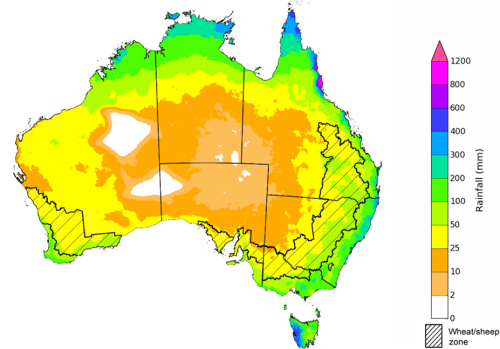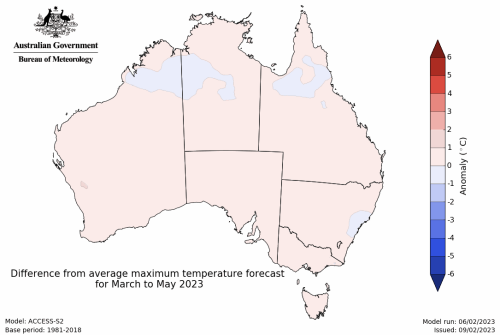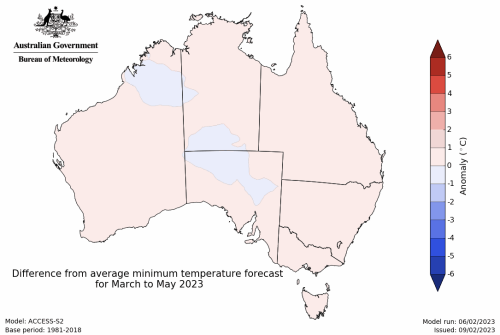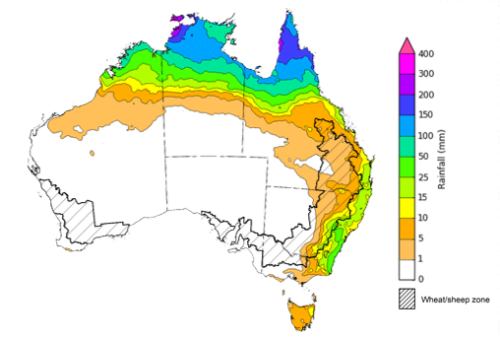Key issues
- For the week ending 8 February 2023, low-pressure systems and associated troughs remained active and resulted in widespread rainfall and localised thunderstorm, mainly in tropical northern Australia.
- Reduced rainfall across summer cropping regions in southern Queensland would have allowed soils profiles to drain, reducing the risk of waterlogging and improving the access to fields for crop maintenance activities and for the harvesting of early sown summer crops to continue. Meanwhile, moderate rainfall across northern Queensland growing regions likely benefited the germination of late sown summer crops (see Section 1.1).
- The La Niña event underway in the tropical Pacific is expected to dissipate by the end February 2023. The currently moderate to strong Madden-Julian Oscillation is over the eastern Indian Ocean and expected to move into the Maritime Continent and towards the western Pacific in the coming week. Those climate drivers are likely to bring above average rainfall to northern and eastern Australia and below average rainfall for western Tasmania during the remainder of summer (see Section 1.2).
- The rainfall outlook for March to May 2023 suggests that large areas of southern Australia have a higher chance of below median rainfall. Below median rainfall is more likely for the Riverina region of southern New South Wales, parts of south-eastern Queensland, central Victoria, much of South Australia and the south of Western Australia and the Northern Territory. In contrast, the chance of exceeding median rainfall is more likely for the Kimberley region of Western Australia, the north of the Northern Territory and Cape York Peninsula region of Queensland. Given lower layer soil moisture levels remain above average for this time of year, below average rainfall during this period is unlikely to negatively impact summer crops growth and yield prospects (see Section 1.3).
- Over the 8-days to 16 February 2023, rainfall is expected to be restricted to northern and part of eastern Australia under the influence of low-pressure system and troughs. Little to no rainfall for summer cropping regions in Queensland and northern New South Wales is expected to allow saturated soils profiles to drain, reducing the risk of waterlogging, benefit crops growth and improving the access to fields for the crop maintenance activities and for the harvesting of early sown crops to continue. The forecast rainfall over much of northern and eastern Australia is likely to build soil moisture levels and benefit pasture growth rates and availability (see Section 1.4).
- Water storage levels in the Murray-Darling Basin (MDB) decreased between 1 February 2023 and 8 February 2023 by 91 gigalitres (GL). Current volume of water held in storage is 23 370 GL which represents 93 percent of total capacity. This is 3 percent or 704 GL more than at the same time last year.
- Allocation prices in the Victorian Murray below the Barmah Choke decreased from $19 per ML on 2 February 2023 to $18 per ML on 9 February 2023. Prices are lower in the Murrumbidgee and regions above the Barmah choke due to the binding of the Murrumbidgee export limit and Barmah choke trade constraint.
Climate
For the week ending 8 February 2023, low-pressure systems and associated troughs remained active over most of the country and resulted in widespread rainfall and localised thunderstorm activity across northern Australia.
Weekly rainfall totals of between 25 and 100 millimetres were recorded across much of Queensland, the north of the Northern Territory, southern Victoria, western Tasmania and the Kimberly and Pilbara regions of Western Australia. Falls in excess of 100 millimetres were recorded across parts of the tropical north of Queensland. In contrast, little or no rainfall was recorded across much of New South Wales, South Australia and southern and inland Western Australia.
Little to no rainfall was recorded across most of the cropping regions, except for parts of northern and western Queensland where weekly total rainfall up to 150 millimetres were recorded. Reduced rainfall across summer cropping regions in southern Queensland would have allowed soils profiles to drain, reducing the risk of waterlogging and improving the access to fields for the crop maintenance activities and for the harvesting of early sown crops to continue. Meanwhile, moderate rainfall across northern Queensland growing regions likely benefited the germination of late sown summer crops.
Rainfall for the week ending 8 February 2023
Note: The rainfall analyses and associated maps utilise data contained in the Bureau of Meteorology climate database, the Australian Data Archive for Meteorology (ADAM). The analyses are initially produced automatically from real-time data with limited quality control. They are intended to provide a general overview of rainfall across Australia as quickly as possible after the observations are received. For further information go to http://www.bom.gov.au/climate/rainfall/
Throughout Australia’s summer period, the climate drivers with the largest potential impact on Australia’s climate patterns are the El Niño–Southern Oscillation (ENSO), the Southern Annular Mode (SAM), and the Madden-Julian Oscillation (MJO). These climate drivers are likely to influence the growth and development of summer crops in northern growing regions and pasture growth across northern Australia with the onset of the northern wet season.
La Niña remains active in the tropical Pacific, but oceanic indicators have weakened from their 2022 peak. Cool sea surface temperatures (SST) anomalies in the central equatorial Pacific continue to weaken, which is consistent with a weakening La Niña. Meantime, cool anomalies off the Kimberley and Pilbara coasts of Western Australia have largely dissipated. Warmer than average temperatures persist to the south of Australia from the eastern Great Australian Bight to waters east of New Zealand, while generally weak warm anomalies persist across the west and north of the Maritime Continent. Trade winds have been stronger than average in the western tropical Pacific Ocean. Elsewhere, trade wind strength was close to average. Cloudiness near the Date Line has been mostly below average, which reflects the easing La Niña event.
The currently positive SAM is expected to ease over the coming fortnight and then remain neutral over the remainder of February. The MJO is currently moderate to strong in strength and over the eastern Indian Ocean and expected to move into the Maritime Continent and towards the western Pacific in the coming week, with a possible decline in strength. Given current and expected conditions, above average rainfall is expected to persist across northern and eastern Australia and below average rainfall is expected for western Tasmania for the reminder of summer.
Difference from average sea surface temperature observations 23 January 2023 to 29 January 2023
International climate model outlooks for the NINO 3.4 region in March 2023
Issued: 31/01/2023
The La Niña event continues in the Pacific Ocean but has weakened from its 2022 peak. While Pacific Ocean temperatures have warmed in recent weeks, atmospheric indicators have yet to respond. Nevertheless, all seven of the international models surveyed predict that central Pacific sea-surface temperatures will be ENSO-neutral during February. The current ENSO outlook from the Bureau of Meteorology indicates this La Niña event may dissipate by the end of February 2023, which is slightly earlier than usual. For the period ending 5 February 2023, the 30-day Southern Oscillation Index (SOI) value was +10.7. For the period ending 29 January 2022, the 90-day value was +12.9. The 30-day value has decreased over the last three weeks while the 90-day SOI has remained relatively similar. La Niña events are associated with above average rainfall across eastern and northern Australia during summer.
30-day Southern Oscillation Index (SOI) values ending 5 February 2023
The Southern Annular Mode (SAM) remains strongly positive and the persistence of a positive phase of the SAM is in part associated with the current La Niña. The SAM refers to the north-south shift of the band of rain-bearing westerly winds and weather systems in the Southern Ocean compared to the usual position. A positive SAM in summer months is associated with increased rainfall for parts of north-eastern Tasmania, eastern Victoria, eastern New South Wales and south-eastern Queensland. It is also associated with decreased rainfall for western Tasmania.
Southern Annular Mode (SAM) daily index
The Madden–Julian Oscillation (MJO) has been in the eastern Indian Ocean and moderate to strong in strength. As of 31 January 2023, it is expected to move into the Maritime Continent and towards the western Pacific in the coming week, with a possible decline in strength. The MJO is a pulse of cloud and rainfall that moves eastwards along the equator. While active over the Maritime Continent, the MJO may increase rainfall over northern Australia and also lead to an increased chance of a monsoon burst returning to the northern Australia.
Madden–Julian Oscillation (MJO) daily index
These climate outlooks are generated by ACCESS–S (Australian Community Climate Earth-System Simulator–Seasonal). ACCESS–S is the Bureau of Meteorology's dynamic (physics-based) weather and climate model used for monthly, seasonal, and longer-lead climate outlooks. For further information, go to http://www.bom.gov.au/climate/ahead/about/.
The Bureau of Meteorology’s latest rainfall outlook for March 2023 indicates wetter than average conditions are expected across the half Australia. The ACCESS-S climate model suggests there is a greater than 55% chance of exceeding median March rainfall totals across much of the New South Wales, Victoria, Tasmania, northern area and Pilbara region of Western Australia, the Northern Territory, parts of South Australia, and western half and far north of Queensland.
The outlook for March 2023 indicates that there is a 75% chance of rainfall totals between 25 and 200 millimetres for tropical northern Australia, eastern and south-eastern coastal areas, as well as Tasmania. Rainfall totals in excess of 200 millimetres are expected for east Arnhem region of the Northern Territory, northern and eastern Cape York Peninsula of Queensland. For the remainder of Australia, rainfall totals are not expected to exceed 25 millimetres.
Across cropping regions there is a 75% chance of rainfall totals of between 10 and 25 millimetres across eastern New South Wales, much of Queensland and small areas of eastern Victoria. There is a 75% chance of less than 10 millimetres of rainfall for the remaining cropping regions.
Rainfall totals that have a 75% chance of occurring March 2023
Issued:09/02/2023
The rainfall outlook for March to May 2023 suggests that large areas of southern Australia have a higher chance of below median rainfall over the next three months. There is a more than 60% chance of below median rainfall for the Riverina region of southern New South Wales, and parts of south-eastern Queensland, central Victoria, much of South Australia and the south of Western Australia and the Northern Territory. In contrast, the chance of exceeding median rainfall is more likely for the Kimberley region of Western Australia, the north of the Northern Territory and Cape York Peninsula region of Queensland.
Bureau of Meteorology rainfall outlooks for March to May have greater than 50% past accuracy across large area of Australia. Outlook accuracy is greater than 65% across Queensland, the Northern Territory and Kimberley region of Western Australia. Past accuracy is low (less than 50%) for inland distracts of Western Australia, parts of north-western New South Wales, eastern and north-western South Australia.
Chance of exceeding the median rainfall March to May 2023
Issued: 09/02/2023
The outlook for March to May 2023 suggests there is a 75% chance of rainfall totals between 25 and 200 millimetres across much of New South Wales, Queensland and Victoria, the south-west and the Kimberley region of Western Australia, the north of the Northern Territory, Tasmania and the far south of South Australia. Rainfall totals in excess of 200 millimetres are forecast for the Top End of the Northern Territory, the Cape York Peninsula of Queensland and western Tasmania.
Across cropping regions, there is a 75% chance of receiving less than 50 millimetres in the cropping regions of western New South Wales, northern and south-western Queensland, large area of Victoria, South Australia, and Western Australia. There is a 75% chance of receiving between 50 and 100 millimetres across eastern New South Wales, central and south-eastern Queensland, as well as the south of Western Australia.
These rainfall totals are below average for this three-month period across most cropping regions. Despite a relatively dry January, recent rainfall during early February has seen upper layer soil moisture levels return to close to average levels across summer cropping regions in New South Wales and Queensland, which will likely support the germination and establishment of late sown summer crops. Lower soil moisture levels are above average to average across large areas of summer cropping regions, which will support yield potentials of earlier sown crops. For both early and late sown summer crops, more rainfall will be required over the coming weeks to support ongoing development and yield potentials.
Rainfall totals that have a 75% chance of occurring March to May 2023
Issued: 09/02/2023
The temperature outlook for March to May 2023 indicates that maximum temperatures across most of Australia are likely to be close to the 1990-2012 average (the difference between -1°C to +1°C). Minimum temperatures across most of Australia are expected to be close to the 1990-2012 average (the difference in the range of 0°C to +1°C) with slightly lower than average temperatures for some pockets in the Kimberly region in Western Australia, southern area of the Northern Territory and adjacent area of South Australia. (Bureau of Meteorology ‘National Climate Outlook’, 9 February 2023).
Predicted maximum temperature anomaly for March to May 2023
Predicted minimum temperature anomaly for March to May 2023
Over the 8-days to 16 February 2023, a monsoon trough and passing active phase of the Madden–Julian Oscillation (MJO) are expected to bring increased rainfall across northern Australia. Low-pressure systems and troughs are expected to bring rainfall to the eastern coast of Australia.
Rainfall totals exceeding 15 millimetres are expected across the north of the Northern Territory, much of northern and parts of south-eastern Queensland, eastern New South Wales, and the Kimberley region in Western Australia. Rainfall totals in excess of 100 millimetres are expected for the far north of Queensland and the Northern Territory. Little to no rainfall is forecast for the remaining area of Australia for the next eight days.
Across Australian cropping regions, little to no rainfall is expected for most cropping regions in the next eight days, except for isolated areas of eastern New South Wales where falls up to 25 millimetres are expected. Little to no rainfall for summer cropping regions in Queensland and northern New South Wales is expected to allow saturated soils profiles to drain, reducing the risk of waterlogging, benefit crops growth and improving the access to fields for the crop maintenance activities and for the harvesting of early sown crops to continue. The forecast rainfall over much of northern and eastern Australia is likely to build soil moisture levels and benefit pasture growth rates and availability.
Total forecast rainfall for the period 9 February to 16 February 2023
Issued 09/02/2023
Water
Water storages, water markets and water allocations - current week
The Tableau dashboard may not meet accessibility requirements. For information about the contents of these dashboards contact ABARES.
Commodities
Information on weekly price changes in agricultural commodities is now available at the Weekly commodity price update.

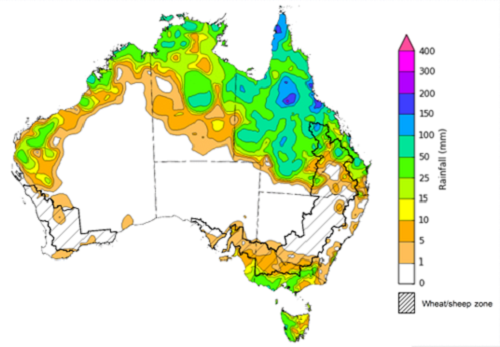
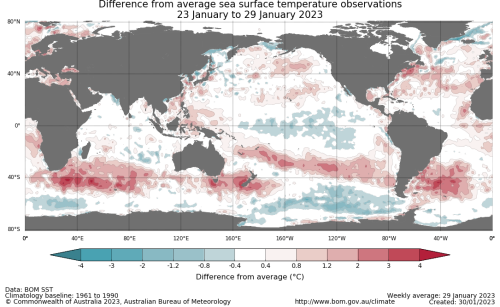
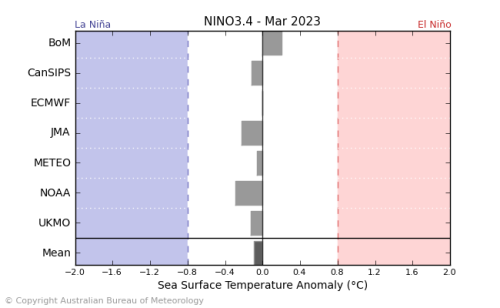
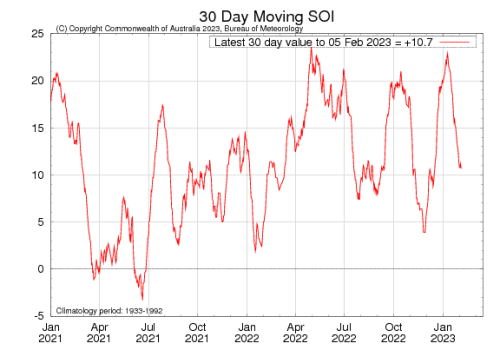
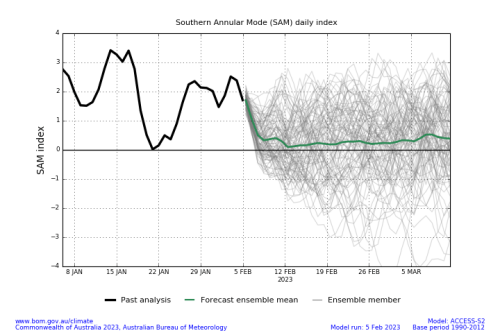

![Map showing the rainfall totals that have a 75% chance of occurring during the next month in Australia. Image provided by the Bureau of Meteorology. Please refer to accompanying text for a more detailed description.]](/sites/default/files/images/rain.forecast.calib_.scenario.75.national.month2_.latest.hr__4.png)
![Map showing the chance of exceeding median rainfall during the next three months in Australia. Image provided by the Bureau of Meteorology. Please refer to accompanying text for a more detailed description.]](/sites/default/files/images/rain.forecast.median.national.season2.latest.hr__5.png)
